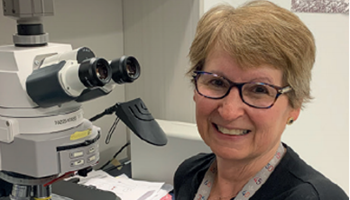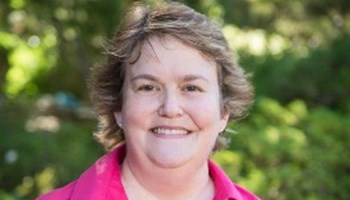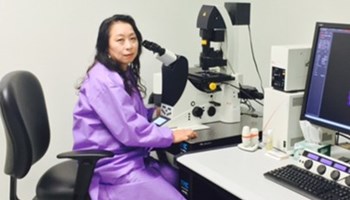 With the demand for FISH (fluorescence in situ hybridisation) testing on the rise in many pathology labs, automating part or all of the workflow can help to ease time and cost burdens. Many labs choose to automate slide processing to achieve this, but these systems also come with some restrictions. Manufacturers typically pre-validate a limited choice of FISH probes and there is uncertainty whether other vendor’s probes can be successfully used, without complicated validation processes.
With the demand for FISH (fluorescence in situ hybridisation) testing on the rise in many pathology labs, automating part or all of the workflow can help to ease time and cost burdens. Many labs choose to automate slide processing to achieve this, but these systems also come with some restrictions. Manufacturers typically pre-validate a limited choice of FISH probes and there is uncertainty whether other vendor’s probes can be successfully used, without complicated validation processes.
Dr Jennie Thurston, Director of Cytogenetics, Carolinas Pathology Group, Atrium Health, spoke to us about how her lab incorporated a slide processor into their workflow to address their ever-increasing sample workload. She explains how Oxford Gene Technology’s (OGT’s) CytoCell FISH probes were seamlessly incorporated into the automated workflow for fast, high quality results. Dr Thurston also shares the benefits and experience gained by her lab as well as her insight on the future of FISH testing in pathology laboratories.
I received my PhD in medical genetics from the University of Alabama at Birmingham, after which I did a fellowship in clinical cytogenetics at Indiana University School of Medicine. I was the assistant director there for 12 years before I was recruited to set up a cytogenetics laboratory for the BayCare Health System in Tampa. In 2014, I joined Carolinas Pathology to direct the cytogenetics laboratory at Atrium Health.
The Parke Cytogenetics Laboratory at Atrium Health is a full-service cytogenetics laboratory that performs chromosome, FISH, and microarray analysis. The FISH lab processes constitutional and cancer samples. For oncology, we analyse peripheral blood and bone marrow specimens, as well as formalin fixed, paraffin-embedded (FFPE) specimens using LDT FISH probes for HER2 amplification in breast and gastric cancer, ALK and ROS1 rearrangements for lung and 1p / 19q deletions in glioma.
We serve a very large hospital system (over 40 hospitals) and the volume of paraffin-embedded tissue samples alone has grown over 50% in the last five years. Clients also request a 24-hour turnaround time and with the increased workload, that turnaround time was not feasible. The lab put together a business plan to buy a new piece of equipment and we purchased an automated slide processor—the VP2000 Processor by Abbott Molecular—in 2013. Our cost analysis estimated that automation would save about twelve hours a week on technician time, based on the workload at that point, and as a result, we would save around $10 per test.
It depends on what kind of probe we’re using, but typically we use two separate slides. One is processed by hand and the other with the VP2000, and then both are scored. We score not only for the analysis—to make sure that they’re both positive or both negative—but we also score for quality. For slide quality we assess a number of parameters, including background, fluorescence intensity, and hybridisation efficiency.
Consistency in the quality of the slides - all the slides are processed in exactly the same way, eliminating inter-technologist variation. In addition, the time and cost benefits that we anticipated have also been realised. Being able to hit the 24-hour turnaround time can be really important in some cases, particularly with breast cancer cases, for example. Before the sample comes to us, the biopsy has been performed, part of it is sent to the pathology lab where it’s fixed, put on microscope slides and stained. The pathologist then has to review it and must make a decision to do additional testing such as HER2 FISH analysis. It’s not until then that the slides get sent to us, which means it’s often several days between the biopsy and the assessment before the slides get to us. Often a follow-up appointment has already been scheduled for the following week so the physician needs the results urgently to determine the next course of action. This applies similarly with lung cancer, where we perform ALK rearrangement analysis, and it may take over a week to get additional test results back prior to FISH analysis.
Prior to my arrival in Charlotte, the lab was only using Abbott’s probes, which are good quality but a bit expensive. As we began to expand our FISH menu, we decided to look at other vendors and compared hybridisation efficiency, signal intensity, and price. The results with OGT’s CytoCell probes were comparable and at a better price. So, as we validated new FISH probes, we switched to CytoCell. Then OGT brought out Fast PML and Fast RARA probes, and we moved to those as well. We already had a PML/RARA probe in house, but we switched to CytoCell because of the availability of a fast hybridisation which greatly decreased our turnaround time. We’ve been using CytoCell probes for two or three years now.
It was very straightforward. We used our current protocol and just ran the slides using our normal settings. I was really hoping that it would work on the same protocol and that we wouldn’t have to change anything – I thought we might need to tweak the pre-treatment, hybridisation time or the denaturing temperature, but it worked just fine without any adjustments, and the quality and signal intensity were very good. The results are definitely comparable to the probes we were using before. Even with the short hybridisation time for the Fast PML and Fast RARA probes, the quality is still very good, with a strong signal intensity, and of course, the price is very good! Everything’s worked very smoothly. We’ve not had any problems.
I would and I have – several times! They’ve been great and OGT’s customer service has been wonderful. We get information about new probes that are coming out and we have access to technical support and technical specialists in the area. We get the right amount of information and support without it becoming intrusive. As I mentioned, we are using the CytoCell Fast PML and Fast RARA FISH Probes, which are wonderful. I would say the quality is as good as our previous supplier, if not superior. The variety of probes that you have access to is a little better than the previous supplier, with a couple of different probe configurations that they don’t have but OGT does. And of course, using the CytoCell probes still enables us to hit our 24-hour turnaround target, which is critical for our laboratory. We are also able to turn results around in less than four hours for our short turnaround time (STAT) cases.
We’ve definitely seen an increase in volume in paraffin embedded FISH. We have been doing HER2 for a long time, then ALK came on the scene, and now ROS1. Requests for RET are coming in as well. More and more oncologists are requesting new probes - I’ve seen a lot of that in the last few years. In terms of new tests, we’re looking at probably taking on RET FISH probes and we’re currently in the process of validating a lymphoma paraffin embedded FISH panel. NGS is growing in many areas and in some cases used in conjunction with FISH. The molecular pathology lab has some targeted NGS panels for their paraffin-embedded solid tumour work and we are working together to bring on a heme NGS panel. I’ve definitely seen an increase in NGS testing, but at the moment the majority of testing is still with FISH. In the future as NGS testing expands, there will still be a continuing need for FISH, in particular, assessing genes that have multiple rearrangement partners. Of course, another advantage of FISH is that we’re able to look at the actual cells in the patient specimen, just like the pathologist does.
I think for paraffin-embedded samples, use of FISH is probably not going to be that affected by newer technologies. Use of FISH for bone marrow samples may start to see a drop as some of the newer technologies develop, but I don’t know if we’ll see it in the next five years.
Turnaround time is still going to be much faster with FISH—and particularly for the rapid PML/RARA test—I don’t see that being replaced anytime soon.
Laboratories must undertake all appropriate validation of any LDT as per 42 CFR 493.1253 - Standard: Establishment and verification of performance specifications.
The tests discussed in this report were developed and their performance characteristics determined by the Parke Cytogenetics Laboratory at Atrium Health. They have not been cleared or approved by the U.S. Food and Drug Administration.
CytoCell®: product availability may vary from country to country and is subject to varying regulatory requirements. Please contact your local representative for availability.

Carmen Vokaty, Assistant-Chief Medical Technologist in Cytogenetics at the McGill University Health Centre, details how her lab incorporated OGT’s Cytocell® Tissue Pretreatment kit into its workflow after struggling with a homebrew solution.
Read
Dr. Theresa C. Brown, Tulane University School of Medicine, answer questions around her AGT 2017 presentation 'FISHing with the real-life laboratory experts.'
Read
Megumi Hada, PhD, Senior Research Scientist, RaISE, Prairie View, Texas A&M. answers our questions on space radiation, how it affects astronaut health, and what her research can teach us about the biological effects of radiation here on Earth.
Read